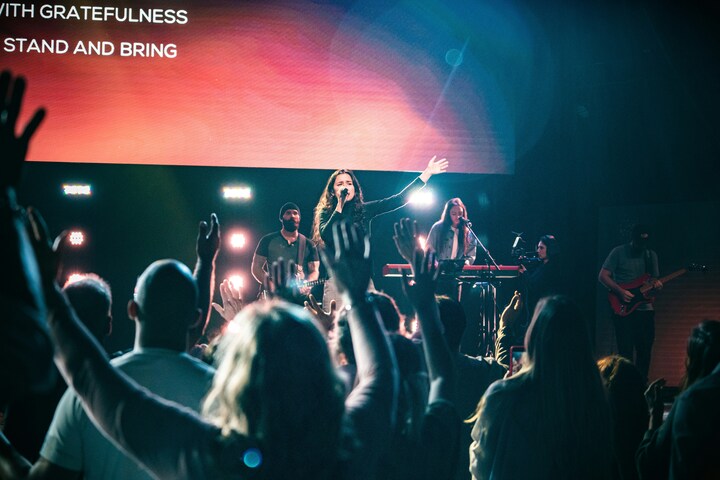
By Matthew Smith
Easter is one of my favorite holidays. It’s a time to gather with family and come together for a celebration of love, hope, and the fulfillment of God’s promise.
I’m grateful to have the opportunity to celebrate Easter with three generations—my parents, my family and brother, and my children. We have a tradition of going to church together and then sharing brunch afterwards. It’s something I cherish and look forward to each year.
And I’m not alone. Many people—even those who might not attend church regularly—look forward to the time together and gathering at their local church.
According to Lifeway Research more than half of U.S. pastors (52%) say Easter Sunday is their most-attended church service of the year. And 90% of pastors identify Easter as the day their church has its highest, second-highest, or third-highest attendance for worship service.
For production teams, these numbers highlight the immense opportunity—and responsibility—that comes with Easter. Whether it’s ensuring the live stream runs without a hitch, the sound system is tuned perfectly, or the stage lights set the right tone for the pastor’s message, production teams are the unsung heroes of Easter Sunday.
It’s your expertise behind the scenes that creates the seamless, meaningful experience congregants enjoy in the pews, or from their living rooms. With so many people attending, watching, and engaging for the first time, this is a chance to make an unforgettable impact—both spiritually and technically.
Preparing beforehand can help mitigate potential missteps. Here are five essential tips from the Resi Media team on how to execute an unforgettable Easter live stream.
#1: Develop a comprehensive run-of-show checklist and schedule
We know it sounds old-fashioned, but writing something down is often the best place to start. A run-of-show list or “run sheet” is a living document that outlines every minute of an event from start to finish.
More than a schedule, a run-of-show should also include a breakdown of the necessary equipment and the names of those responsible for each aspect of the production. When crafting your list, think about every detail: Who’s handling the camera angles? What time do you need to switch from worship to the sermon? Are there specific moments where the lighting needs to shift or where pre-recorded content will play? These fine details ensure nothing is overlooked when the pressure’s on.
The earlier you start on your run-of-show sheet for your Easter service, the better. You can always fill in or adapt to any changes or specifics as the day approaches, but having a foundation will keep your team aligned.
#2: Organize and confirm your Easter volunteer team
As anyone who works in ministry knows, your busiest seasons tend to be the weekends, when your staff and volunteers are most likely to take vacation or time off—and Easter Sunday is no different.
That’s why it’s absolutely vital to nail down who will be available to work the Good Friday and Easter Sunday services weeks in advance. Be clear about expectations: Are you asking someone to show up an hour before service starts, or do they need to stay for the entire day? Knowing your team’s limits and schedules ahead of time can help you avoid unnecessary stress on the big day.
#3: Make live streaming a strategic priority
Initially embraced as a quick solution to stay connected with congregants during the pandemic, live streaming has evolved into a cornerstone of many churches’ online presence. According to Pushpay’s recent State of Church Technology Report, 91% of churches live stream their worship services.
For production teams, live streaming is no longer an add-on; it’s a primary way to reach your congregation and community. Think of your live stream as a digital front door for your church.
It can reach people who may not yet be ready to attend in person. I draw comparisons to Matthew 18:12-14, which speaks to God’s care and pursuit of those “outside of the flock” – streaming can help reach those who are lost and lonely.
That’s why it’s vital to make finding and accessing your live stream as easy as possible. If you’re planning a direct mail campaign in your community, include a QR code that links directly to the stream. Do the same on your social media channels and place a can’t-miss banner on your church website. It should be easy and clear to anyone who’s remotely curious about joining your Easter live stream.
That also means the experience matters. The quality of your stream—from smooth transitions to clear audio—can shape someone’s perception of your church within minutes — if not seconds. Placing strategic importance on your live stream will help draw people back beyond the Easter service.
#4: Conduct a complete audit on your live stream and production equipment
Easter services often come with a lot of expectations, and as a production team, those expectations might land on your shoulders to make it happen. That’s why a proactive equipment audit is non-negotiable.
Take time to test every cable, button, and connection well in advance. If you’ve been eyeing new equipment or software, now’s the time to invest and test it—before Easter Sunday itself. Also, make sure all your software is up-to-date with any firmware updates and ready to handle the increased demand.
#5: Formalize your follow-up strategy for visitors
Your church is likely to see a big boost in attendance Easter weekend. While it’s good to prepare for that influx, it’s more important to have a plan for what comes after Easter. Your welcoming team likely already encourages people to fill-out connection cards, and you probably have a slide doing the same in your pre-show announcement reel. But those connection points are limited to in-person attendance.
If you’re going to place more strategic weight on it this Easter, then it’s paramount that your live stream not be a passive experience — especially when it comes to follow-up. Incorporating clickable QR codes into your stream that lead to digital connection cards (or giving opportunities) can help further bridge the gap between online viewers and in-person attendees in real-time.
An effective follow-up strategy also involves finding effective ways to repurpose content for re-engagement. For example, you could edit the live stream recording and share it through follow-up emails, offer on-demand access, or post it on social media platforms. Either way, work alongside your ministry team to ensure your new guests know where to learn more, leaving them with a clear path forward as they seek to engage with your church.
Closing
Easter is a day of significance, joy, and renewal. As a production team, your work is integral to creating an environment where congregants and visitors alike can experience those truths in meaningful ways. By preparing well, embracing your role as storytellers through technology, and leading with intentionality, you can create a service that resonates far beyond the holiday itself.
As General Manager of Resi Media, Matt and team lead and empower faith organizations to reliably connect and engage with their community. Resi Media delivers end-to-end live streaming software and hardware solutions specializing in high-quality transmissions for the web, social media destinations, multisite, and over-the-air applications.








